Moroccan Chicken Tagine – Chicken braised in a rich spice-infused sauce studded with chickpeas and dried apricots. Just, YUM! Serve over couscous for an authentic eating experience.
After you’ve made this, try Vegetable Tagine. Meat-free deliciousness!
Chicken tagine
Tagine is a classic North African stew made with meats and vegetables braised in a gently spiced sauce. It is traditionally made in a conical-lidded earthenware pot called a tagine (from where the dish obviously gets its name!) A tagine’s lid is shaped so all the steam trapped in the dome drips back into the dish as condensation, keeping the dish moist as it slowly stews.
There are many varieties of tagines. Meat, fish and all manner of vegetables can make their way into this stew. Nuts and preserved fruits like figs, apricots, lemon or olives are also often added to for flavour and interest. Today I’ve picked a Moroccan chicken tagine with dried apricots and chickpeas.
And don’t worry! You don’t need an actual tagine to make this – we’re going to use a boring old pot! 😂
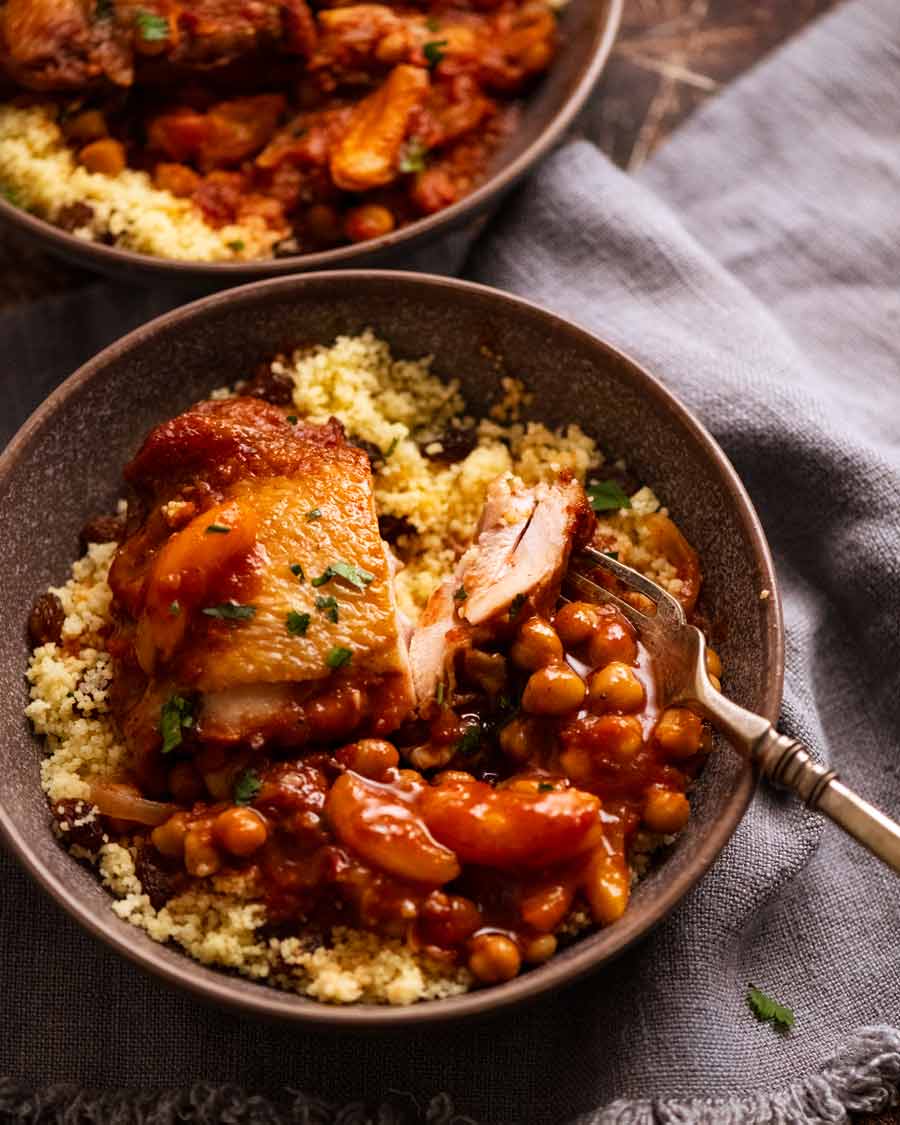
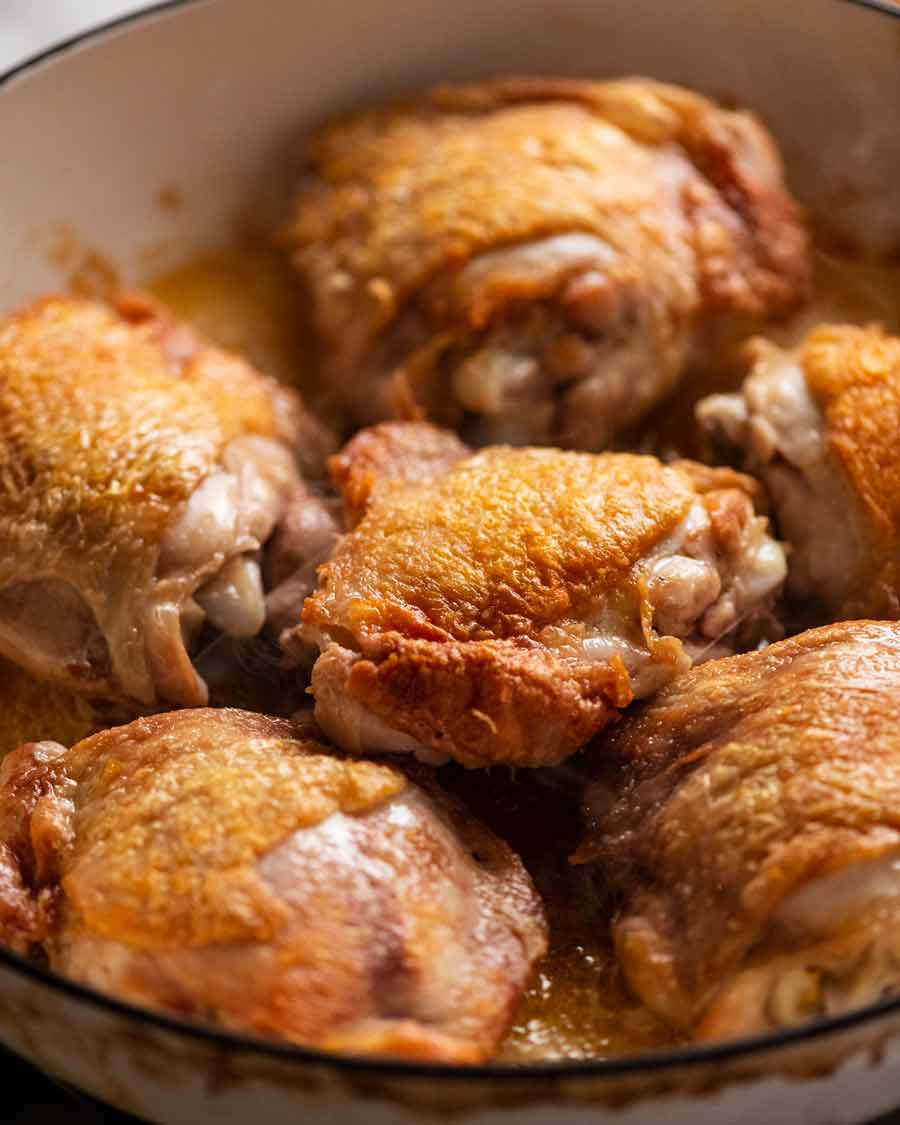
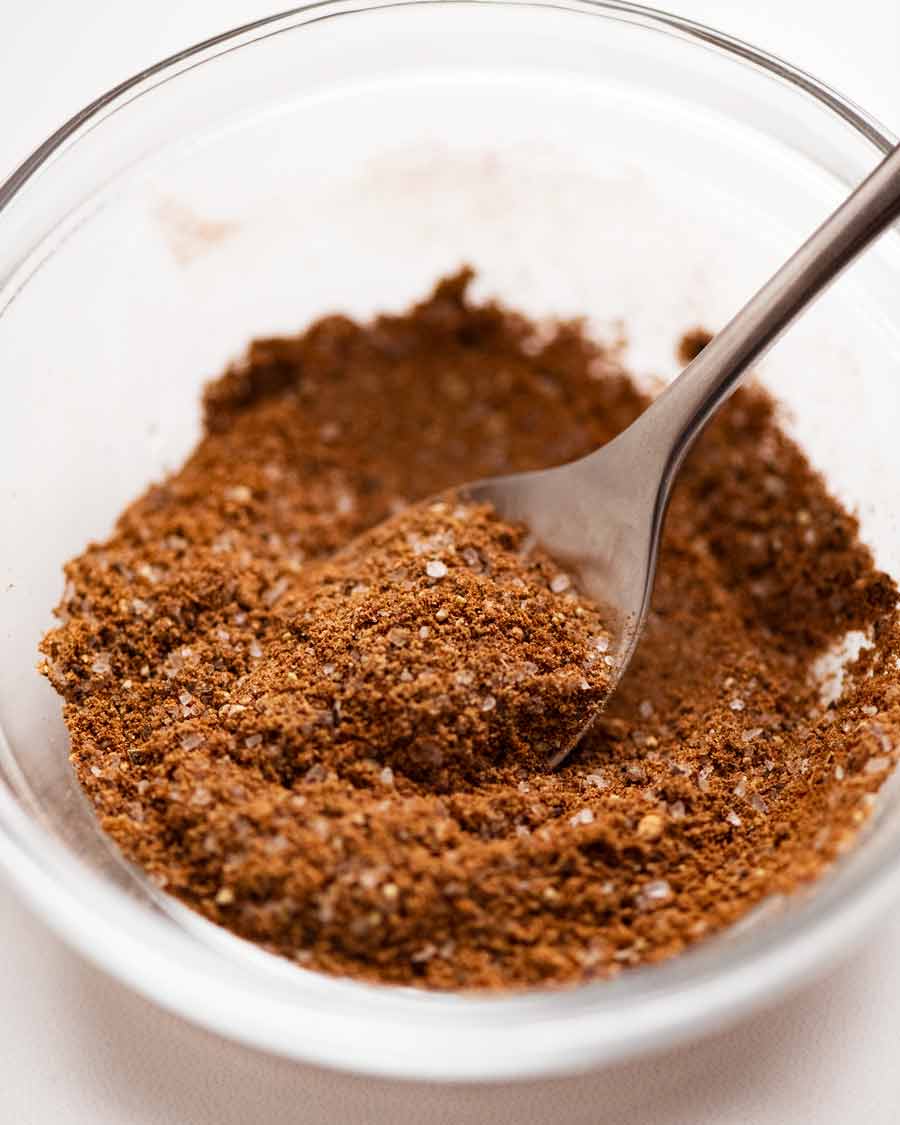
What goes in Chicken Tagine
The spice mix used in this Morrocan chicken tagine is Rasa el hanout, a spice blend common in North Africa used in many dishes. While you can buy pre-made blends, the balance of flavours can be unpredictable from brand to brand. It’s so much better to make your own for a consistent outcome – and it’s cheaper too!
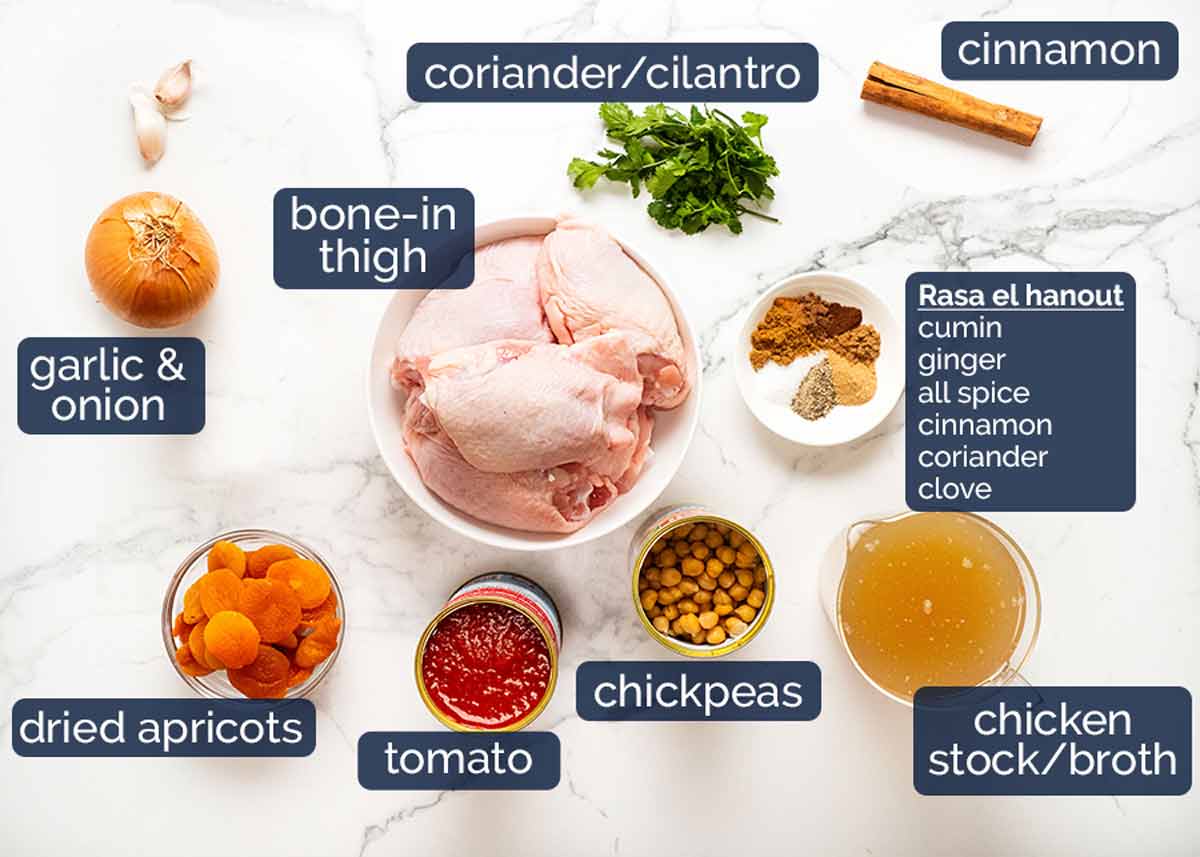
-
Bone-in skin-on chicken thighs are the best cut for a tagine because they are still juicy after the 25 minutes simmering time required to thicken the sauce and allow the flavours to develop.
Chicken legs are a terrific alternative. Just follow the recipe as written. Boneless thighs and breast will work but the cook method is best altered to add them back in partway through the sauce simmering time else they will overcook. I’ve popped directions in the notes. 🙂
-
Rasa el hanout – The spice blend for tagine, made with common spices you may already have! You can buy blends but I prefer to make my own to get the right balance of flavours. The nice thing here is that because we’re using a fair few different spices here, it’s not the end of the world if you’re missing one … or even two. I’ve offered a few switch-out options in the recipe notes!
-
Cinnamon stick – Added to the sauce as it simmers for a beautiful perfume and flavour. I love the scent cinnamon this adds to the dish!
-
Dried apricots – As mentioned earlier, some versions of tagine are made with olives, others use dried fruit, other still may use both. I’ve opted for fruit because it’s one of the few dishes I love that pairs fruit with meat! However I am personally not really a fan of both dried fruit and olives together – it’s just a little too much, I find. Let one or the other shine, I say!
However, the recipe includes the olive option too.
-
Chickpeas – Chickpeas add some more heft to the dish. I just use canned for convenience but I’ve popped directions in the notes for cooking dried. Other beans, like cannelloni and butter beans, make fair substitutes, as do lentils.
-
Garlic and onion – Essential for the sauce flavour base. It’s rare to see saucy recipes on this website that don’t start with these!!
-
Canned tomato – For the sauce base. Not strictly traditional but I love how it thickens the sauce so it clings to the couscous better. Without, the sauce is very watery in consistency. While traditional tagines are supposed to be like that, I prefer a stewy sauce!
-
Chicken stock – To add depth to the sauce. If you just use water, you’ll find the sauce a bit bland.
For convenience, I typically use store-bought but homemade chicken stock would take this to another level. Also, vegetable stock would be a good substitute.
-
Coriander / cilantro – A fresh garnish. Recommended, but not a deal-breaker if you’re one of those people who can’t stand coriander. Or if the price of coriander has sky-rocketed to dizzying levels lately, as it has here in Sydney due to extreme weather conditions! 😭
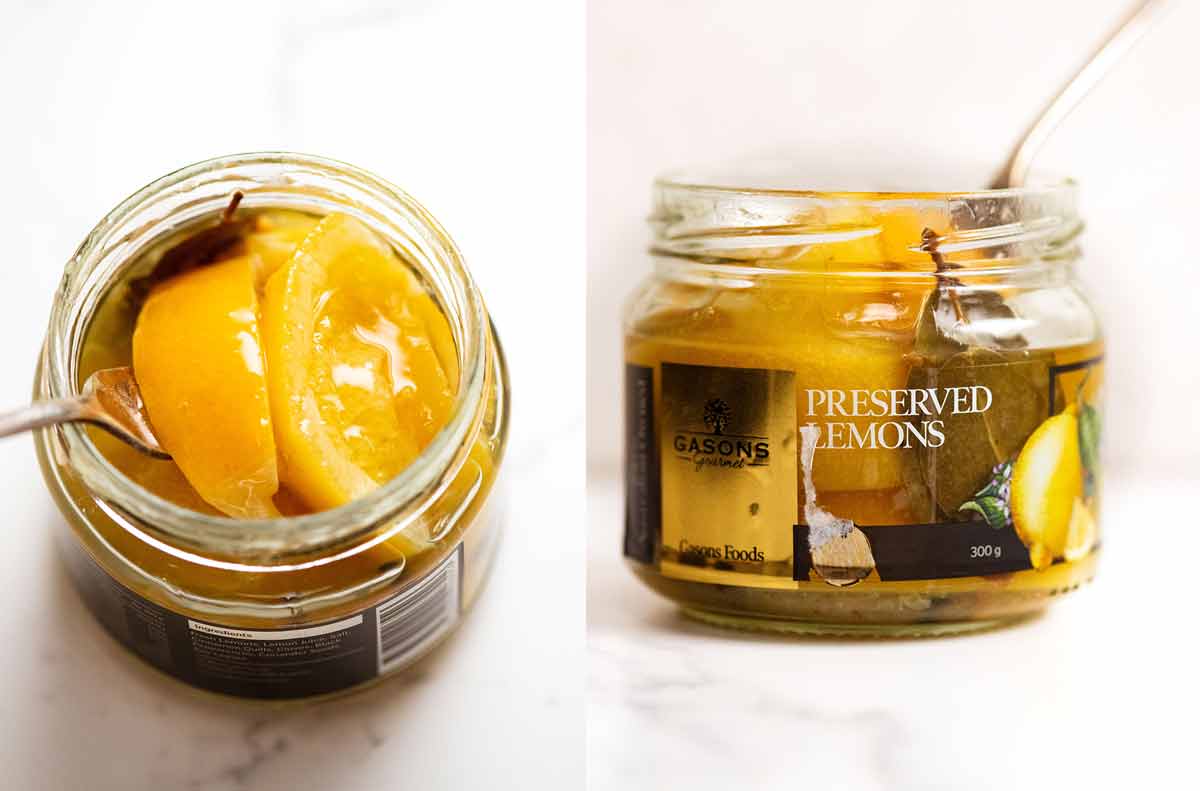
-
Preserved lemon – An ingredient used in Moroccan and some Indian cooking that is often used in traditional tagines. Accidentally omitted from the ingredients photo above, so I’m giving it air time with a big photo! 😂
Preserved lemon is lemon simply pickled in salt. The salt mellows the sharpness of the lemon juice and transforms the flavour remarkably, intensifying the earthiness of the lemon flavour in the zest.
These days it’s fairly easy to find at large grocery stores in Australia (Coles, Woolies, Harris Farms) but don’t fret if you can’t find it. Tagine is still worth making without it!
How to use preserved lemon: We only use the rind as this is where all the flavour is! Take a piece out of the jar and scrape off the pith (white part of rind) and pulp using a teaspoon (it’s extremely salty and also bitter). Rinse the rind thoroughly under tap water to remove excess salt then finely mince it with a knife.
How to make Chicken Tagine
Brown the chicken skin until golden, then braise in the spice-infused sauce. Simple!
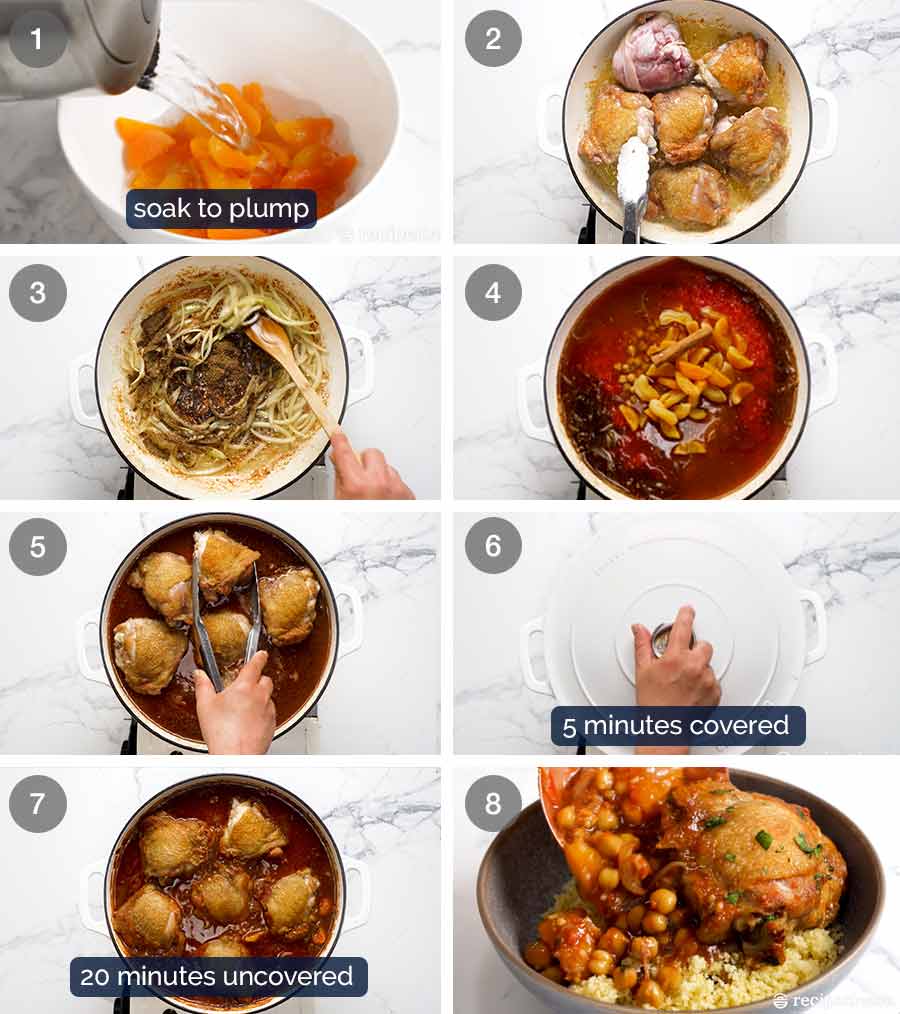
-
Plump up apricots – Cover the dried apricots with boiling water then leave for 30 minutes to plump up.
-
Brown chicken – Season the chicken with salt and pepper and brown the skin really well in a pan. This takes a good 8 to 10 minutes. Don’t shortcut this step! The browned skin adds a stack of flavour to the chicken, plus it leaves behind golden bits stuck on the pan (called “fond”) which imparts valuable flavour to the sauce.
Once the skin side is nicely browned, sear the other side for just 1 minute then remove. The chicken won’t be cooked through at this stage. We will finish cooking it in the sauce.
-
Sauté aromatics and spices – Sauté the onion and garlic, then cook off the spices briefly. Sautéing spices before adding liquids is a good tip for releasing more flavour from the spices. It certainly does for tagines!
-
Tagine sauce – Add the chickpeas, tomato, preserved lemon, stock and cinnamon stick. Stir, then bring it to a simmer.
-
Top with chicken – Just place the chicken on top, skin side up. It will be partially submerged but the flesh should mostly be under the liquid while the skin mostly sits above the liquid which is exactly what you want as this way, the browning on the skin is mostly preserves during the braising.
-
Simmer covered 5 minutes – Adjust the heat as needed so it’s simmering gently. Not too rapidly else the base of the pot will scorch.
-
Simmer uncovered 20 minutes – Remove the lid then simmer uncovered for 20 minutes, or until the internal temperature of the chicken is 70°C/158°F (which may be slightly less than 20 minutes). Don’t worry about going above this temperature as bone-in chicken thighs are a very juicy cut so they’re very forgiving.
-
Serving! Tagine is traditionally served over couscous. I’ve popped a little more information below with some couscous flavouring options as well as some alternatives for other carb-y partners.
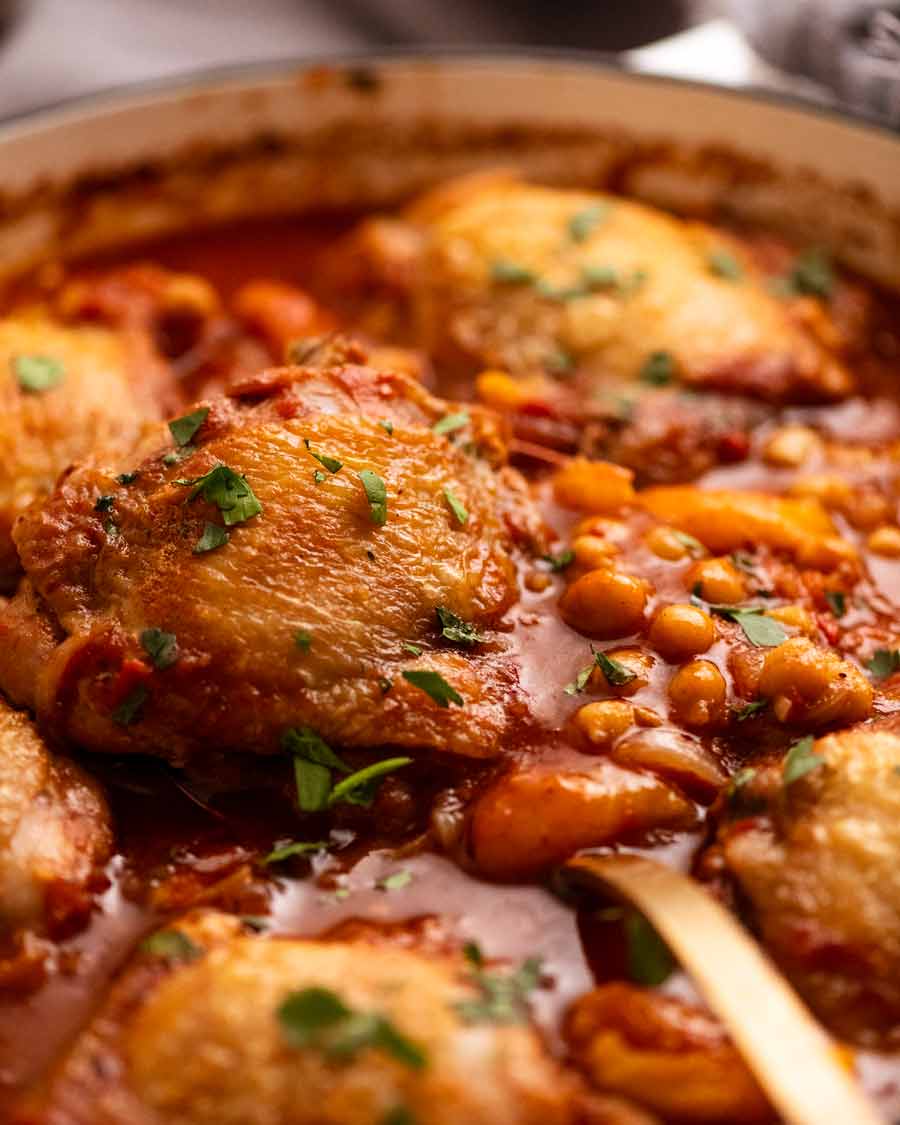
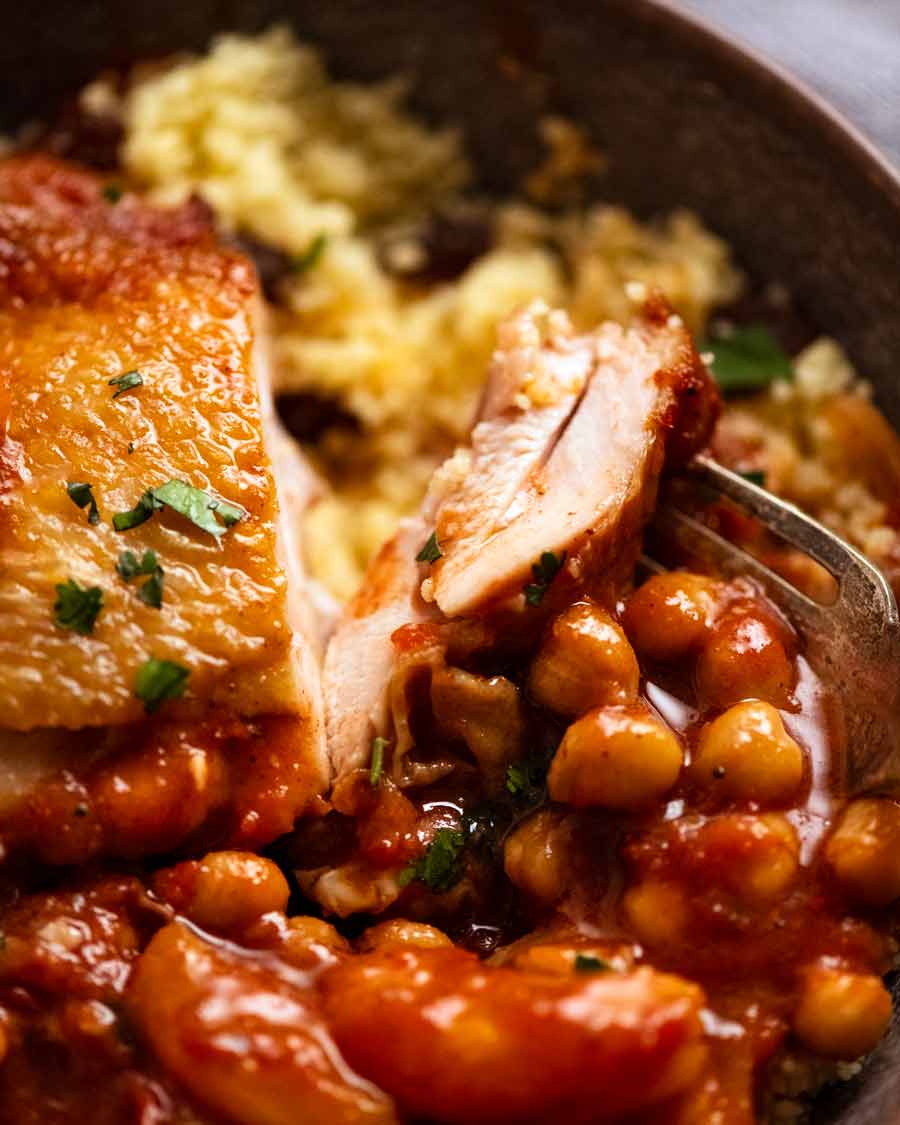
What to serve with Chicken Tagine
Couscous
Tagine is frequently served over couscous. Plain couscous is fine though it’s really nice with a little sprinkle of dried fruit and/or nuts littered throughout, or a spritz of fresh lemon. You’ll find various flavouring options in the couscous recipe.
Other starchy vehicle options
Rice (white, brown, basmati), pearl couscous (the giant ones), quinoa and any other small-grain starchy things suitable for sauce-soaking make good alternatives. Even mashed potato or mashed cauliflower would be great. Just something to slop up all that delicious sauce!
If you’re attempting the low carb thing, then Cauliflower Rice will work well too. Actually, I think the slight nutty flavour from roasting the cauliflower rice will go really nicely with Chicken Tagine!
Side Salad
I think a light, simple side salad is nice to pair with spice-infused dishes like Chicken Tagine. Some suggestions:
If you’re wanting to make more of an impact, try one of these:
Or – find your own perfect side salad here. 🥬
Love to know what you think if you try this! – Nagi x
Watch how to make it
Hungry for more? Subscribe to my newsletter and follow along on Facebook, Pinterest and Instagram for all of the latest updates.

Chicken Tagine
Servings6
Tap or hover to scale
Ingredients
Ras el hanout spice blend (Note 4):
Alternative add in options
Instructions
-
Plump apricots – Soak the dried apricots in a bowl of boiling water for 30 minutes, then drain (this plumps them up).
-
Season chicken – Sprinkle both sides of the chicken with the salt.
-
Brown chicken – Heat oil the oil in a large, deep skillet or pot (Note 5) over high heat. Place chicken in the skillet skin side down and cook for 8 to 10 minutes until deep golden. Turn and cook the flesh side for 1 minute then remove to a plate.
-
Sauté aromatics & spices – Discard all but 2 tablespoons of fat in the skllet. Reduce heat to medium. Add onions and cook for 3 minutes. Add garlic and cook for 1 minute. Add the Ras el hanout and stir for 30 seconds.
-
Tagine sauce – Add the cinnamon stick, tomato, chickpeas, plumped apricots, stock and preserved lemon, then stir. Place the chicken on top, skin side up.
-
Simmer covered 5 minutes – Bring the liquid to a simmer then cover with a lid (Note 6). Cook for 5 minutes, adjusting the heat as needed so the liquid is simmering (but not too rapidly else base may catch).
-
Simmer uncovered 20 minutes – Remove lid then cook for a further 20 minutes or until the internal temperature of the chicken is at least 70°C/158°F (Note 7).
-
Serve – Remove from stove and rest for 5 minutes. Serve over couscous (Note 8), sprinkled with fresh coriander.
Recipe Notes:
2. Preserved lemon – An ingredient used in Moroccan and Indian cooking, this is lemon that is pickled in salt. The sharpness of lemon juices is mellowed and the earthiness of lemon flavour in the zest is intensified. Adds a touch of authenticity to tagines but don’t fret if you can’t find it, tagine is still worth making without it. Available at most large grocery stores in Australia.
TO PREPARE: We only use the rind as this is where all the flavour is! Take a piece out of the jar and scrape off the pith and pulp using a teaspoon. Rinse the rind thoroughly under tap water to remove excess salt then finely mince it with a knife.
3. Spices – You won’t be left lacking if you are missing a spice (maybe even two). Make up for it by dialling up the ones you have.
4. Cooking vessel – If you have an actual tagine, kudos to you! I use my 30cm / 12″ wide shallow cast iron casserole dish. Any large deep skillet or big pot will work fine. If it has a lid, even better. If not, don’t worry – just cover with a baking tray or foil for the covered simmering step.
5. Internal temp – Chicken thighs are a nice juicy cut so you can cook it well over the target internal temp – even as high as 85°C/185°F – and it’s still juicy. (Can’t say the same for breast!).
6. Olive option – Skip the dried apricots, use 1 cup of kalamata olives, pitted, or green olives. No need to plump them up! Add in with the tomato.
My personal preference is not to use both dried fruit and olives (I just don’t really enjoy the combination, it’s too much competing flavours). Feel free to use both together if you prefer!
7. Nuts – Slivered almonds, lightly toasted until golden in a dry skillet, go really nicely in tagines.
8. Couscous – I use this recipe of mine. Also terrific with rice.
Nutrition Information:
Calories: 198cal (10%)Carbohydrates: 32g (11%)Protein: 8g (16%)Fat: 6g (9%)Saturated Fat: 1g (6%)Polyunsaturated Fat: 1gMonounsaturated Fat: 3gTrans Fat: 1gCholesterol: 1mgSodium: 995mg (43%)Potassium: 686mg (20%)Fiber: 7g (29%)Sugar: 16g (18%)Vitamin A: 947IU (19%)Vitamin C: 8mg (10%)Calcium: 81mg (8%)Iron: 3mg (17%)
Life of Dozer
Who me? 👼🏻






